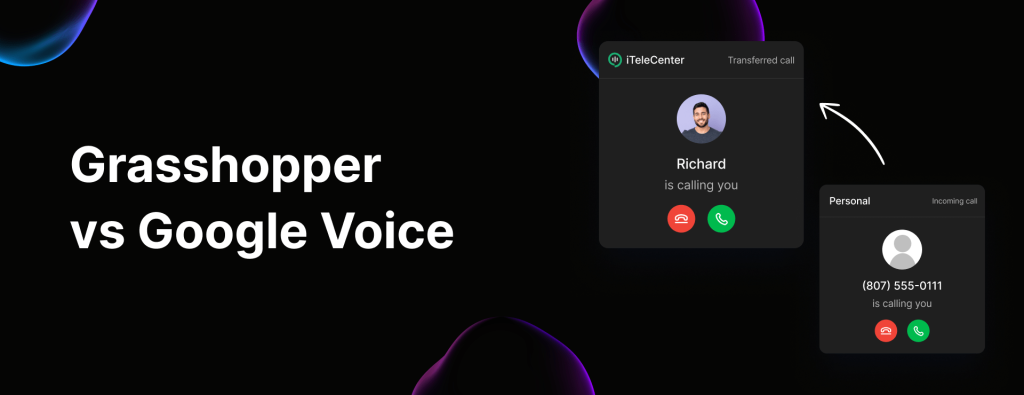How to start a virtual call center – Costs, software, and setup guide

Curious about how to start a virtual call center? Well, you’ve come to the right place! We have simplified everything you need to know about setting up a virtual call center – from selecting the right virtual call center software to the step-by-step process of getting your customer service operations up and running in no time.
Let’s get started!
What is a virtual call center?
Think of a virtual call center as one that’s spread out at several locations rather than a centralized physical office. A virtual call center is like a traditional call center—but way more flexible with way less operational cost. Instead of working out of a building, employees use cloud-based VoIP software like iTeleCenter to connect with customers from their homes or any remote location.
This setup uses advanced call center technology like VoIP telephony software, cloud-based communication platforms, and other digital tools.
The best part? Virtual call centers can be set up with a small budget and scaled up as your business grows. Whether you want to handle customer support, tech support, or sales, a virtual call center business can get the job done without the need for a big office space.
Types of virtual call centers

There are three types of virtual call centers:
- Inbound call center: What do you do when you face technical issues with your laptop or mobile phone? You reach out to their customer support and the agent on the other end walks you through troubleshooting steps and offers solutions, right? That is what inbound call center services entail. They handle incoming calls from customers or prospects.
- Outbound call center: In an outbound call center, agents call customers. At some point in your life, you must have received calls from companies promoting their services or products or conducting surveys. They use outbound call center services to do so.
- Hybrid call center: Hybrid call centers are a mix of inbound and outbound call centers, where agents handle both incoming and outgoing calls. This type of call center is ideal for businesses looking to maximize resource utilization and provide a seamless experience for their customers. For example, think of banking institutions like Wells and Fargo, where inbound calls might focus on customer queries related to account balances or fraud reporting, and outbound calls could be used to follow up on loan applications or promote new financial products.
Why start a virtual call center?
Virtual call centers offer numerous benefits. They leverage the power of modern technology to deliver seamless communication, greater flexibility, and reduced costs. Let’s understand why establishing a virtual call center can be a game-changer for your business:
- Low operational costs: Reduced cost is one of the primary benefits of a virtual call center. Unlike physical call center, they don’t require office space, equipment or utilities, as they operate in the cloud. This setup eliminates the need for renting office space and purchasing hardware, resulting in substantial savings.
- Access to global talent pool: You get to hire the best talent from around the world, without being limited to any specific geographical location. Your best customer service agents could be sitting halfway around the world! This setup is especially beneficial for companies catering to the global customer base, as they can hire bilingual agents based on where their customers are located, without having to hire or own a physical office in that location.
- Scalability: Want to expand your team? Just hire more virtual call center employees . No need to worry about fitting everyone into a limited office space. With a virtual call center, scaling your operations is much simpler and more efficient. Adding new agents or expanding to support new communication channels (such as live chat or video calls) can be done with just a few clicks.
- Greater flexibility for agents: It can’t be denied that remote work culture helps both the companies as well as its employees. Virtual call centers allow agents to work remotely, providing them with greater flexibility in their work environment and schedules. This flexibility can lead to higher job satisfaction, lower employee turnover, and improved overall productivity.
- Easy integration with modern call center technology: Virtual call centers use advanced call center technology that integrates seamlessly with CRM software, analytics tools, and VoIP telephony software. It makes it easier for businesses to track, monitor, and optimize their customer interactions in real-time. For instance, virtual call centers companies can deploy call monitoring tools to assess agent performance, track customer satisfaction scores, and analyze call data for actionable insights.
- Better equipped for unforeseen circumstances: Virtual call centers ensure business continuity in the event of unforeseen circumstances, such as natural disasters, power outages, or pandemics. Because they operate on cloud-based communication platforms, agents can continue working from any location, ensuring uninterrupted service.
How to start a virtual call center?

If you’re thinking, “Okay, I get it. Now, how do I start a virtual call center?” Don’t worry, we’ve got you covered. Here’s a step-by-step breakdown:
1. Determine your business goals and niche
The first step is to decide what type of services you want to offer. Are you focusing on inbound call center solutions like customer support or tech help? Or are you more interested in running an outbound call center for telemarketing or surveys?
Knowing your niche helps you understand the type of virtual call center software and tools you’ll need.
2. Choose the right call center software
This is the backbone of your entire operation. Look for virtual contact center software that offers:
- VoIP virtual software: Helps with smooth call connectivity.
- Call monitoring Tools: Allows you to keep track of agent performance.
- Video conferencing tools: Great for team meetings and training sessions.
Some top contenders in 2024 include RingCentral, iTeleCenter, and Nextiva.
3. Build a remote team
Hire skilled agents that fit your business goals. Websites like Upwork, Freelancer, and LinkedIn are good places to start. Make sure to train your team well to provide consistent, high-quality support.
4. Set up the necessary equipment and technology
Don’t skimp on a good headset, stable internet connection, and cloud-based communication platforms. These tools are essential for smooth operations.
5. Establish operational processes and KPIs
Create a workflow that defines how tasks are assigned and handled. Establish key call center metrics like average handling time, first-call resolution, and customer satisfaction scores.
Also, remember, data protection is crucial. Make sure your software is compliant with U.S. regulations like CCPA (California Consumer Privacy Act) and GDPR if you’re dealing with international clients.
Choosing the right call center software for your virtual call center
Choosing the best software can feel like choosing a superhero to join your team. You need a sidekick that’s reliable and powerful. Here’s what to look for:
- CRM integration: Easily access customer details during calls.
- Omnichannel support: Manage communication through calls, emails, and social media – all in one place.
- Scalability: Choose software that allows you to add new users or features as you grow.
Costs involved in setting up a virtual call center
Starting a virtual call center is like setting up a mini spaceship for your business.
The good news? You don’t need a lot of capital or funding …
Here’s a quick cost breakdown:
- Initial setup costs: Computer, headset, VoIP virtual software, and software licenses.
- Operational costs: Monthly software subscriptions, internet, and employee salaries.
With smart planning, you can keep the costs low and still offer top-notch virtual call center solutions.
Challenges of running a virtual call center and how to overcome them
Virtual call centers come with their own set of challenges. For example:
- Communication gaps: Regular meetings through video conferencing tools can help.
- Time zone differences: Use scheduling tools to plan shifts effectively.
- Employee engagement: Use virtual team-building activities to keep morale high.
Future of virtual call centers in the U.S.
Virtual call centers are evolving rapidly. With AI-powered chatbots, predictive dialing, and web-based customer service tools, they’re becoming more efficient than ever. Experts predict that the hybrid call center model (a mix of remote and physical agents) will be the future norm for many businesses.
Starting a virtual call center isn’t rocket science. With the right tools, a skilled team, and a solid plan, you can create a thriving virtual call center that serves customers worldwide. Remember, the key is to start small, monitor your progress, and scale as you grow.
Frequently asked questions
How much does it cost to start a virtual call center?
It depends on your setup, but you can start with minimal costs and expand as needed.
Can I start a virtual call center from home?
Absolutely! With the right technology and tools, you can manage everything remotely.
What are the legal requirements for operating a virtual call center in the U.S.?
You’ll need to comply with data protection regulations like CCPA and possibly GDPR if you handle international clients.
How can I recruit remote agents for my virtual call center?
Use platforms like Upwork, Freelancer, and LinkedIn. Make sure to conduct thorough interviews and provide training.
What is the best software for virtual call centers in 2024?
Top picks include iTeleCenter, Nextiva, and RingCentral. Choose based on your business needs.
How can I ensure data security in a virtual call center?
Use secure software and follow best practices like encryption and access control.
What are the key metrics to track in a virtual call center?
Average handling time, first-call resolution, and customer satisfaction.
What are the challenges of managing a virtual team?
Communication gaps, time zone differences, and engagement. Regular meetings and activities help.
How can I scale my virtual call center efficiently?
Hire more agents as demand grows and leverage cloud-based tools to add new features.
Table of Contents
Test drive iTeleCenter for free
Try for free



